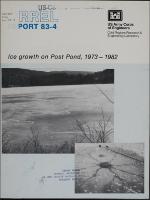Please use this identifier to cite or link to this item:
https://hdl.handle.net/11681/9277Full metadata record
| DC Field | Value | Language |
|---|---|---|
| dc.contributor.author | Gow, A. J. (Anthony Jack) | - |
| dc.contributor.author | Govoni, John W. | - |
| dc.date.accessioned | 2016-06-20T13:41:03Z | - |
| dc.date.available | 2016-06-20T13:41:03Z | - |
| dc.date.issued | 1983-02 | - |
| dc.identifier.uri | http://hdl.handle.net/11681/9277 | - |
| dc.description | CRREL Report | - |
| dc.description | Abstract: Measurements and analysis of seasonal ice growth and decay on Post Pond, New Hampshire, for the period 1973-1982 are presented. Observations included ice thickness measurements, examination of the various ice types contributing to the ice cover, and measurements of meteorological parameters for correlation with and modeling of the ice growth process. The overall nature of ice growth and decay (ice loss) on Post Pond has been ascertained, the seasonal variability in the timing of freeze-up and ice-out and the duration of the ice cover have been determined, and the relationship of ice growth to freezing-degree-day (°C) records evaluated on the basis of a Stefan conduction equation modified to deal with ice sheets covered with or free of snow. Ice growth occurs predominantly by the direct freezing of lake water, but snow ice may compose as much as 50% of the ice cover in winters with higher than average snowfall. Freeze-up leading to the establishment of a stable ice cover occurs during the 4-week period from the end of November to the end of December. Maximum seasonal ice thicknesses were from 45 to 67 cm and are generally attained during the first two weeks of March; ice-out, marking the final disappearance of ice from Post Pond, usually occurs by the third week of April. The overall rate of ice loss is three to four times that of ice growth, and is dominated initially by melting from the top. As much as 50% of the ice may be lost in this way before the onset of any bottom melting. Final dissipation of the ice cover is usually expedited by candling resulting from preferential melting and disintegration of the ice at crystal boundaries. | - |
| dc.publisher | Cold Regions Research and Engineering Laboratory (U.S.) | - |
| dc.publisher | Engineer Research and Development Center (U.S.) | - |
| dc.relation | http://acwc.sdp.sirsi.net/client/en_US/search/asset/1025981 | - |
| dc.relation.ispartofseries | CRREL report ; 83-4. | - |
| dc.rights | Approved for public release; distribution is unlimited. | - |
| dc.source | This Digital Resource was created from scans of the Print Resource | - |
| dc.subject | Ice | - |
| dc.subject | Lake ice | - |
| dc.subject | Ice growth | - |
| dc.subject | Ice decay | - |
| dc.subject | Ice breakup | - |
| dc.subject | Ponds | - |
| dc.subject | Post Pond, New Hampshire | - |
| dc.title | Ice growth on Post Pond, 1973-1982 | - |
| dc.type | Report | en_US |
| Appears in Collections: | CRREL Report | |
Files in This Item:
| File | Description | Size | Format | |
|---|---|---|---|---|
| CR-83-4.pdf | 4.98 MB | Adobe PDF |  View/Open |